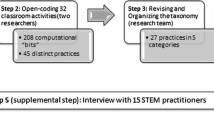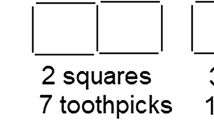Abstract
This paper examines the effectiveness of programming in pairs in the Scratch environment in primary school. The motivation for tackling this issue is based on the successful use of Scratch as a learning environment for any students of programming. The analysis has shown that that programming in pairs produces better results for beginners in comparison to programming as an individual student. The obtained results are in a positive correlation with the students’ general school success and show that there are no differences in achievement between boys and girls. The Scratch environment has allowed learning to become more interesting, more challenging and more creative.
Similar content being viewed by others
References
Baytak, A., & Land, S. M. (2011). An investigation of the artifacts and process of constructing computers games about environmental science in a fifth grade classroom. Educational Technology Research and Development, 59(6), 765–782.
Brown, Q., Mongan, W., Kusic, D., Garbarine, E., Fromm, E., & Fontecchio, A. (2013). Computer aided instruction as a vehicle for problem solving: Scratch programming environment in the middle years classroom. Proceedings of the Annual Conference and Exposition, Pittsburg, Pensilvania USA.
Golmez, I., & Ozdner, N. (2015). Academic achievem in computer programming instruction and effects of the use of visualization tools at the elementary school level. British Journal of Education, Society and Behavioural Science, 11(1), 1–18.
Hannay, J. E., Dyba, T., Arisholm, E., & Sjøberg, D. I. (2009). The effectiveness of pair programming: A meta-analysis. Information and Software Technology, 51(7), 1110–1122.
Hsu, H.M.J. (2014). Gender differences in scratch game design. Proceedings of the International Conference on Information, Business and Education Technology (ICIBET 2014). Beijing, China.
Ismail, M. N., Ngah, N. A., & Umar, I. N. (2010). Instructional strategy in the teaching of computer programming: A need assessment analyses. The Turkish Online Journal of Educational Technology, 9(2), 125–131.
Kalelioglu, F., & Gulbahar, Z. (2014). The effects of teaching programming via scratch on problem solving skills: A discussion from learners’ perspective. Informatics in Education, 13(1), 33–50.
Kaucic, B., & Asic, T. (2011). Improving introductory programming with scratch? Proceedings of the 34th International Convention (MIPRO), Osijek, Croatia, pp. 1095–1100.
Koorsse, M., Cilliers, C., & Calitz, A. (2015). Programming assistance tools to support the learning of IT programming in South African secondary schools. Computers & Education, 82, 162–178.
Krathwohl, D. R. (2002). A revision of Bloom’s taxonomy: An overview. Theory and Practice, 41(4), 212–218.
Lai, A., & Yang, S. (2011). The learning effect of visualized programming learning on 6th graders’ problem solving and logical reasoning abilities. Proceedings of the International Conference on Electrical and Control Engineering (ICECE), Yichang, China, 6940–6944.
Lee, J. Y., Oh, S. Y., & Kim, S. B. (2016). A pair programming scheme for an educational programming language. Advanced Science and Technology Letters, 137, 139–143.
Lewis, C. M. (2011). Is pair programming more effective than other forms of collaboration for young students? Computer Science Education, 21(2), 105–134.
Lewis, C. M. and Shah, N. (2012). Building upon and enriching grade four mathematics standards with programming curriculum, Proccedings of the 43rd ACM Technical Symposium on Computer Science Education, Raleigh, USA, 57-62.
Lister, R., & Leaney, J. (2003). Introductory programming, criterion-referencing, and bloom. ACM SIGCSE Bulletin, 35(1), 143–147.
Meerbaum-Salant, O., Armoni, M., & Ben-Ari, M. (2013). Learning computer science concepts with scratch. Computer Science Education, 23(3), 239–264.
Ouahbi, I., Kaddari, F., Darhmaoui, H., Elachqar, A., & Lahmine, S. (2015). Learning basic programming concepts by creating games with scratch programming environment. Procedia-Social and Behavioral Sciences, 191, 1479–1482.
Pajares-Pescador, R., Hernandez-Díez, C., & Cardenoso-Payo, V. (2014). Study of the educational impact of activities using Scratch in first-year students in secondary education. Proceedings of 6th International Conference on Education and New Learning Technologies, Barcelona, Spain, pp. 3138–3144.
Saez-Lopez, J. M., Román-González, M., & Vázquez-Cano, E. (2016). Visual programming languages integrated across the curriculum in elementary school: A two year case study using scratch in five schools. Computers & Education, 97, 129–141.
Shin, S., Park, P., & Bae, Y. (2013). The effects of an information-technology gifted program on friendship using scratch programming language and clutter. International Journal of Computer and Communication Engineering, 2(3), 246–253.
Su, A., Yang, S. J., Hwang, W. Y., Huang, C. S., & Tern, M. Y. (2014). Investigating the role of computer-supported annotation in problem solving based teaching: An empirical study of a scratch programming pedagogy. British Journal of Educational Technology, 45(4), 647–665.
Tekerek, M., & Altan, T. (2014). The effect of scratch environment on student’s achievement in teaching algorithm. World Journal on Educational Technology, 6(2), 132–138.
Vieira, C., & Magana, A. (2013). Columbian elementary students’ perfomance and perceptions of computing learning activities with scratch. 12th ASEE Annual Conference and Exposition, Atlanta, Georgia, USA.
Werner, L., & Denning, J. (2009). Pair programming in middle school: What does it look like? Journal of Research on Technology in Education, 42(1), 29–49.
Wilson, A., & Moffat, D.C. (2010). Evaluating scratch to introduce younger schoolchildren to programming. Proceedings of the 22nd Annual Psychology of Programming Interest Group Universidad Carlos III de Madrid, Leganés, Spain.
Zhong, B., Wang, Q., & Chen, J. (2016). The impact of social factors on pair programming in a primary school. Computers in Human Behavior, 64, 423–431.
Author information
Authors and Affiliations
Corresponding author
Additional information
Publisher’s note
Springer Nature remains neutral with regard to jurisdictional claims in published maps and institutional affiliations.
Rights and permissions
About this article
Cite this article
Iskrenovic-Momcilovic, O. Pair programming with scratch. Educ Inf Technol 24, 2943–2952 (2019). https://doi.org/10.1007/s10639-019-09905-3
Received:
Accepted:
Published:
Issue Date:
DOI: https://doi.org/10.1007/s10639-019-09905-3




